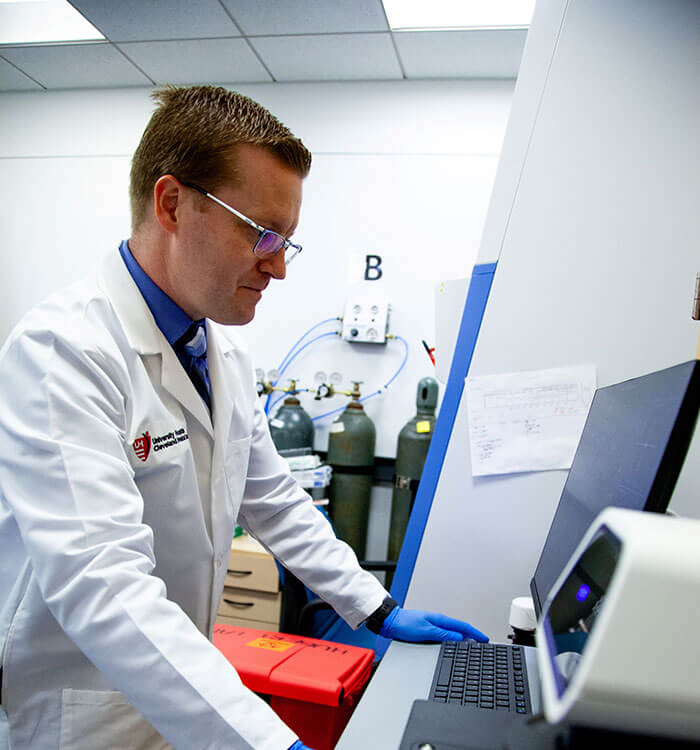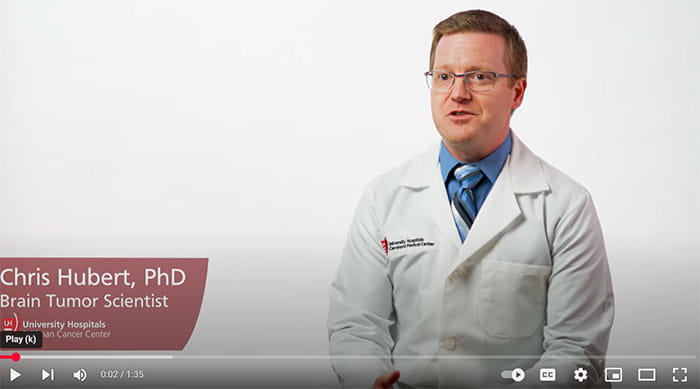Tiny Lab-Generated Microtumors Could Revolutionize Brain Cancer Treatment
October 23, 2024
Innovations in Cancer | November 2024
Brain tumors are incredibly complex, with a variety of cells and different microenvironments and niches where these cells are growing. The perivascular niche, for example, is fed with abundant oxygen and nutrients by nearby blood vessels and is enriched with stem cells. Necrotic regions and hypoxic areas are farther from the blood vessels and cells in or near these regions are driven by different signaling processes. Add in the interactions of differing tumor cells cooperating or competing for resources, and the diversity and complexity of the brain tumor becomes a formidable challenge.
 Chris Hubert, PhD
Chris Hubert, PhDIt is this very complexity, in fact, that is limiting efforts to improve survival for tumors like glioblastoma, where most patients can only expect to live 12 to 18 months after diagnosis. That’s the view of Chris Hubert, PhD, a new brain tumor researcher at UH Seidman Cancer Center.
“We've been pouring millions of dollars and decades of time into brain tumor research, but we're not substantially moving the needle for patients,” he says. “We can model, treat, kill and cure this disease in our lab cultures and in our mice. We need to ask: why aren't these things translating to the patients that we're trying to help?"
Dr. Hubert’s research aims to help change that. His groundbreaking work involves developing more accurate models of how brain tumors actually function in a person, with the goal of providing better testing grounds for new and emerging therapies. He and his team take cells from patients’ brain tumors and use them to grow three-dimensional miniature tumors in the lab called organoids.
“We're overestimating how good our drug is by studying them in small numbers of fast-growing cells in these typical adherent or sphere lab models,” he says. “The diversity and variation in a clinical tumor dramatically exceeds what we typically model in the lab. That’s what brought me to developing these new, more diverse systems. Organoids contain a spectrum of cancer cells from the same original tumor, growing in different environments, yet still affecting each other and increasing the drug resistance of the entire whole.”
Each organoid is about the size of a lentil, containing millions of cells.
“The cultures are much, much larger than a traditional cell culture on a plastic dish, with millions and millions of cells growing together, communicating and competing with each other,” Dr. Hubert says. “With this large-scale micro-tissue culture, we get a lot more cellular diversity, and we get interactions between the cells that change their biology. Because of this, we can see some of the cell diversity that exists in patients, and that gives rise to a lot of the therapeutic resistance that clinicians must face.”
Dr. Hubert has seen this himself, where multiple candidate drugs that killed cancer cells in 96 well plates had little to no effect on the organoids.
“That’s three-dimensional resistance,” he says. “That's a drug that looks beautiful in in the lab models, but which isn't going to help a patient when it goes to clinical trial.”
To more effectively employ organoids in his research, Dr. Hubert has also sought to make them more standardized. The tiny microtumors are known to vary between people in the same lab and even made by the same individual.
“We've come up with ways to make sterile molds in the lab, which allow us to create these microtumors, all with starting with the same number of cells in the same distribution, in the same volume and the same shape,” he says. “We get some very reproducible and experimentally viable structures that we can research in the lab.”
Additionally, he and his team have developed technology to sort and individually study cells from different microenvironments within the organoid. Already, they’ve discovered interesting behavior by cells in the organoids, where cells treated with standard chemotherapies currently used in the clinic respond by pausing their growth to escape killing by the drugs.
“I'm suspicious that our glioblastoma cells, when confronted with the standard of care therapies, are exiting the cell cycle,” he says. “They're going dormant to evade the therapy and not die. We don’t know whether they re-enter and regrow later. That’s something we hope to figure out in the future.”
Dr. Hubert is clear that organoids will never replace other research methods in the fight against brain tumors. At the same time, he’s motivated by the potential organoids have to help create better outcomes for brain cancer patients. There may be fewer agents that progress to clinical trials, he says, but with more potential for success. He also believes a new standard of care will likely involve not just one “silver bullet” drug, but instead a combination of agents that mirrors the diversity of the tumor.
“The goal is to be more efficient and bring the right drugs to patients,” he says.
Contributing Expert
Chris Hubert, PhD
Scientist, UH Seidman Cancer Center



